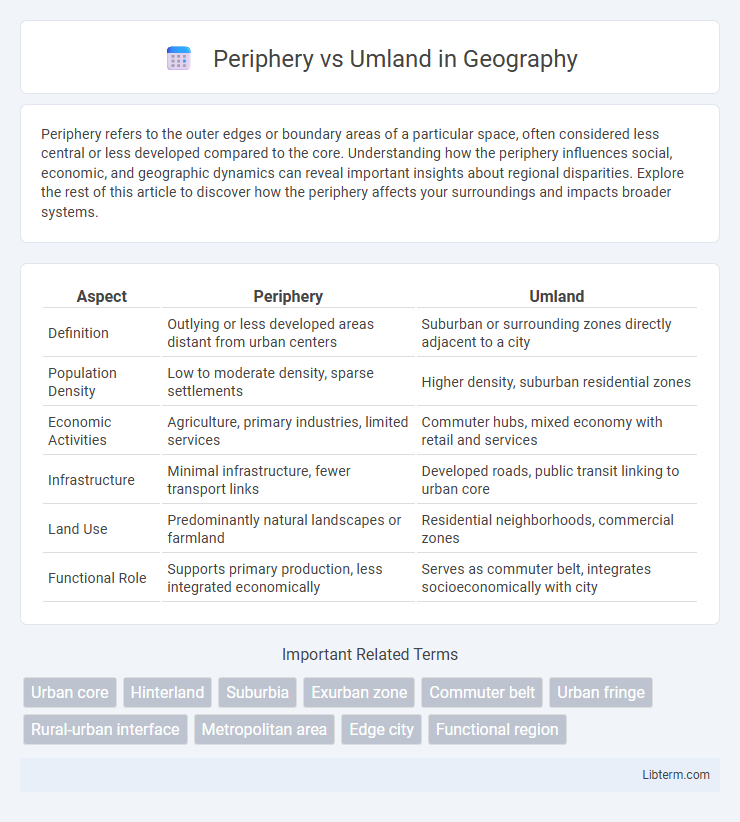Periphery refers to the outer edges or boundary areas of a particular space, often considered less central or less developed compared to the core. Understanding how the periphery influences social, economic, and geographic dynamics can reveal important insights about regional disparities. Explore the rest of this article to discover how the periphery affects your surroundings and impacts broader systems.
Table of Comparison
| Aspect | Periphery | Umland |
|---|---|---|
| Definition | Outlying or less developed areas distant from urban centers | Suburban or surrounding zones directly adjacent to a city |
| Population Density | Low to moderate density, sparse settlements | Higher density, suburban residential zones |
| Economic Activities | Agriculture, primary industries, limited services | Commuter hubs, mixed economy with retail and services |
| Infrastructure | Minimal infrastructure, fewer transport links | Developed roads, public transit linking to urban core |
| Land Use | Predominantly natural landscapes or farmland | Residential neighborhoods, commercial zones |
| Functional Role | Supports primary production, less integrated economically | Serves as commuter belt, integrates socioeconomically with city |
Understanding Periphery: Definition and Key Features
Periphery refers to areas on the margins of economic or political centers, characterized by lower levels of industrialization, infrastructure, and investment compared to core regions. Key features of periphery zones include limited access to advanced technology, reduced economic diversification, and often a reliance on primary industries such as agriculture or raw materials extraction. Understanding periphery involves analyzing these structural disparities that affect development potential and social dynamics within the region.
Defining Umland: Origins and Core Concepts
The term "Umland" originates from German geography, referring to the suburban or peripheral areas surrounding a central city or metropolitan core, emphasizing spatial and functional relationships. Core concepts of Umland include its role as a transitional zone where rural and urban characteristics blend, affecting commuting patterns, land use, and socio-economic interactions. This concept contrasts with "Periphery," which often denotes more remote, less integrated regions with weaker ties to urban centers.
Historical Evolution of Periphery and Umland
The historical evolution of periphery and umland regions reveals distinct patterns of economic and social development influenced by geographic proximity to urban centers. Peripheries often experienced delayed industrialization and infrastructural investment compared to their umland counterparts, which traditionally served as immediate hinterlands supporting urban economies through agriculture and resource provision. Over time, shifting transportation networks and urban expansion have progressively redefined these zones, with some peripheries transforming into dynamic economic areas while umland regions retain roles in both suburbanization and rural preservation.
Geographic Distinctions: Mapping Periphery vs Umland
Periphery regions typically represent the outermost areas of a territory characterized by lower population density and limited economic infrastructure, while Umland refers to the surrounding suburban or semi-urban zones adjacent to urban centers with stronger socioeconomic integration. Geographic distinctions between Periphery and Umland are often mapped based on factors such as distance from urban cores, transportation connectivity, and land use patterns. Spatial analysis utilizing Geographic Information Systems (GIS) reveals that Umland zones serve as transitional areas facilitating commuting and resource exchange, contrasting with the more isolated and rural nature of Periphery regions.
Socioeconomic Characteristics of Periphery Zones
Periphery zones are characterized by lower income levels, higher unemployment rates, and limited access to education compared to urban centers or Umland regions. These areas often exhibit reduced infrastructure development and fewer economic opportunities, contributing to social disparities and slower socioeconomic growth. The lack of investment in healthcare, transportation, and technology further exacerbates the marginalization of peripheral communities relative to more prosperous Umland zones.
Umland’s Role in Urban-Rural Dynamics
The Umland serves as a vital interface between urban centers and rural areas, facilitating economic exchange, labor mobility, and cultural interaction. It supports sustainable regional development by balancing urban expansion pressures with the preservation of agricultural land and natural resources. The dynamic relationship between Umland and core cities enhances spatial cohesion and mitigates socio-economic disparities in metropolitan regions.
Periphery vs Umland: Economic Functions
Periphery regions often rely on primary sectors such as agriculture, mining, and low-value manufacturing, while Umland areas typically serve as economic hubs with diversified industries including services, high-tech manufacturing, and finance. Umland zones benefit from advanced infrastructure and higher investment inflows, fostering innovation and business growth, whereas Periphery areas face challenges like limited market access and lower capital accumulation. The economic disparity between Periphery and Umland influences regional development, labor mobility, and spatial economic policies.
Challenges and Opportunities in Periphery and Umland
The periphery faces challenges such as limited infrastructure, lower access to healthcare, and fewer educational resources compared to the Umland, which benefits from better connectivity and economic opportunities. Economic diversification and digitalization present growth opportunities in peripheral areas by attracting remote work and niche tourism, while the Umland's proximity to urban centers drives investment and job creation. Strategic regional planning can leverage Umland's resources to support peripheral development, fostering balanced growth and reducing disparities.
Case Studies: Comparing Periphery and Umland in Global Cities
Case studies of global cities reveal that the periphery often experiences slower economic growth and limited infrastructure compared to the umland, which benefits from proximity to urban cores and better connectivity. The umland typically shows higher real estate development, improved transportation networks, and greater access to services, fostering increased socioeconomic opportunities. Spatial analysis highlights disparities in income levels, employment rates, and urban amenities, emphasizing the need for integrated regional planning to bridge gaps between periphery and umland areas.
Future Outlook: Integrating Periphery and Umland for Sustainable Development
Integrating Periphery and Umland regions fosters balanced regional growth by promoting infrastructure connectivity, resource sharing, and coordinated urban planning to enhance economic resilience. Sustainable development initiatives prioritize green technologies, transport networks, and social inclusion to address disparities and leverage complementary strengths. Future outlook emphasizes collaborative governance models that align environmental sustainability with economic opportunities, ensuring long-term prosperity for both areas.
Periphery Infographic

 libterm.com
libterm.com